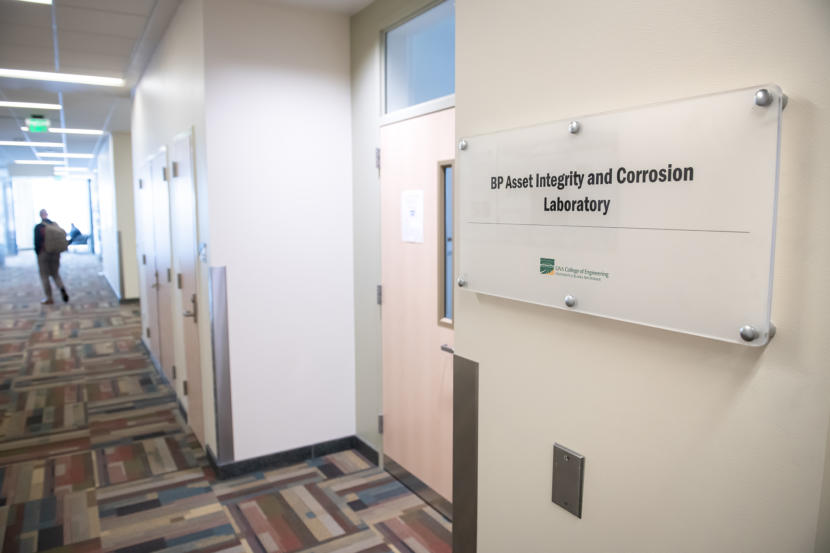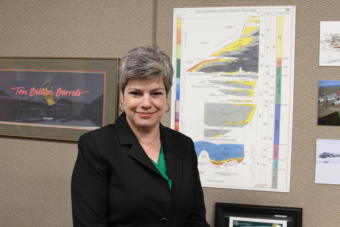
The head of the College of Engineering at the University of Alaska Anchorage said he found out about BP’s proposal to sell its entire Alaska business to Hilcorp the same way a lot of people did.
“We just heard it from the news like everybody else,” said Kenrick Mock, the interim dean. “And then it was, ‘Oh no. What’s next?’”
BP has long supported the university’s engineering programs, Mock said. It funds youth summer camps and university clubs. Its employees sit on the college’s advisory board.
The company’s departure from the state, Mock said, will leave “a huge hole” at the already cash-strapped university.
“There’s so many things that BP has helped fund,” he said.
UAA is among the nonprofits and programs in Alaska that have long benefited from BP’s donations and employee volunteers — and among those now adapting to a changing philanthropic scene.
Hilcorp’s giving strategy is more about individual employee donations than corporate sponsorship. And, a national expert says, that’ll diffuse donations and make them harder to predict — at least at first. Alaska nonprofit executives say it will require some of the state’s philanthropic organizations to rethink their strategies and diversify their donors.
A different way of giving
Over its 60 years in the state, BP has grown into a major philanthropic force, said Laurie Wolf, president and chief executive of The Foraker Group, an Anchorage-based organization that works with and advises nonprofits.
“And it’s not just in terms of their philanthropic financial investment, but also just in the way that they have encouraged their employees to get involved and engaged in the nonprofit sector,” she said.

BP reports donating $4 million to Alaska organizations in 2018. It hosts teacher awards, funds scholarships and pays for the bright-colored bags for a statewide trash cleanup program.
“We came in and we’ve gotten involved as a big, international oil company with a local energy company touch and feel,” Janet Weiss, president of BP Alaska, said in an interview last month.
“I think that Hilcorp comes in and evolves that model even further,” she said. “The way that Hilcorp operates is, they really unleash their employees.”
Hilcorp, a private company, is poised to buy BP’s entire Alaska business in a $5.6 billion deal. It estimates its Alaska employees will donate $5 million to charities over the next 12 months.
At an event in Anchorage in January, Hilcorp Alaska Senior Vice President David Wilkins said the company’s giving program centers on employee choice.
“We give away a lot of money through our employees, and that will remain to be the cornerstone of our program,” Wilkins told the crowd.
Under Hilcorp’s philanthropy program, the company gives each of its new employees $2,500 to donate to qualified charities of their choice. It also matches employees’ donations up to $2,000 each year.
“In extraordinary cases, corporate sponsorships are considered,” the company’s website says.
Hilcorp says it expects to triple its Alaska workforce as a result of the BP sale, growing from about 500 employees to about 1,500. That includes about 750 BP employees that will move to Hilcorp.
“That means we’re going to be giving a lot of money in the community,” Wilkins said.
But where exactly that money will go is anyone’s guess. As is how much of it will stay in the state.
“Chances are, many Alaskan charities will benefit. However, the distribution of the money is in the hands of Hilcorp employees,” said Elizabeth Miller, vice president of communications and development at The Alaska Community Foundation, which recently announced that it will manage Hilcorp’s giving program for the company’s Alaska workers.
Hilcorp declined an interview request for this story. In a statement, the company said it aims to build a greater community of giving by empowering its employees.
Since 2012, Hilcorp said, its employees have donated more than $2.8 million to almost 400 Alaska-based organizations, including food banks, youth shelters, athletic groups and churches. Nationally, Hilcorp reports the largest chunk of its employees’ donations — some 42%, or about $6.3 million — has gone to religious causes.
That’s not surprising, Wolf said. While most corporations don’t donate to religious institutions, individuals do, she said.
“Giving starts at home, and for many people home starts with their religious congregation, whatever that might be for them,” she said.
‘A bucket of cold water’
Eileen Heisman, president and CEO of the National Philanthropic Trust, a Pennsylvania-based nonprofit that advises donors, said the transition from corporate giving to a more individualized approach could be a “bucket of cold water” for some of the nonprofits that have leaned on BP.
“You’re going to go from a bird’s-eye view, very organized, corporate look at everything in the community and where the most important needs are, to many individuals deciding what they’re personally interested in,” she said.
“And I think it’s going to diffuse the giving in a way that’s going to be really hard to predict at this point, but after a year or two the charities that have been depending on BP are probably not going to be able to depend on the individual donors.”
Heisman said one big question is how many dollars will stay in Alaska, since the money can go to any qualifying nonprofit in the country.
“Some of them might want to be giving money back to the communities they lived before, or where they grew up or some other place that’s important to them or where their kids might be living,” she said.
Hilcorp says it will encourage employees to donate to charities in Alaska.
Wolf, with The Foraker Group, said Hilcorp’s giving program isn’t better or worse than BP’s. It’s just different. (The Foraker Group has received just under $1 million from BP, she said.)
“The real impact is that you don’t just write a proposal to a ConocoPhillips and a BP and an Exxon and go, ‘OK, I’m good, I’ve done my corporate grant-making process, right?’ Now you go like, ‘The landscape is way bigger, and I have to really be thinking about being in a relationship with a whole myriad of groups now,’” she said.
And that, Wolf said, will take more time and more strategy. It’s writing 20 proposals instead of three.
As for UAA and its engineering college, Mock said they are already making changes. That includes searching for new sponsors and raising summer camp fees.
“With this new landscape, we actually do foresee having a lot of companies pitching in smaller amounts,” he said.
The entire University of Alaska is also pivoting in that direction. BP has donated about $36 million to the public university system, according to Megan Olson, UAA vice chancellor for university advancement.
In a statement, Olson said universities across the country typically receive the majority of donations from individuals and just a small portion from corporations and foundations.
“It has been just the opposite at the University of Alaska historically, and we have recognized for a while the need to reduce our reliance on corporate philanthropy,” she said.
As for the bright-colored bags used to pick up litter, BP will still partially sponsor them this year, and the Alaska Oil and Gas Association is stepping in to fund the other half, said Anita Nelson, executive director of Alaskans for Litter Prevention and Recycling.
“But we’re not sure what 2021 will look like,” she said.
The future of BP’s teacher awards is still uncertain.
